Azetidine-2-Carboxylic Acid-Induced Oligodendrogliopathy: Relevance to the Pathogenesis of Multiple Sclerosis
- PMID: 35521963
- PMCID: PMC9123080
- DOI: 10.1093/jnen/nlac028
Azetidine-2-Carboxylic Acid-Induced Oligodendrogliopathy: Relevance to the Pathogenesis of Multiple Sclerosis
Abstract
The naturally occurring imino acid azetidine-2-carboxylic acid (Aze) is consumed by humans and can be misincorporated in place of proline in myelin basic protein (MBP) in vitro. To determine Aze effects on the mammalian CNS in vivo, adult CD1 mice were given Aze orally or intraperitoneally. Clinical signs reminiscent of MBP-mutant mice occurred with 600 mg/kg Aze exposure. Aze induced oligodendrocyte (OL) nucleomegaly and nucleoplasm clearing, dilated endoplasmic reticulum, cytoplasmic vacuolation, abnormal mitochondria, and Aze dose-dependent apoptosis. Immunohistochemistry demonstrated myelin blistering and nuclear translocation of unfolded protein response (UPR)/proinflammatory molecules (ATF3, ATF4, ATF6, eIF2α, GADD153, NFκB, PERK, XBP1), MHC I expression, and MBP cytoplasmic aggregation in OL. There were scattered microglial nodules in CNS white matter (WM); other CNS cells appeared unaffected. Mice given Aze in utero and postnatally showed more marked effects than their dams. These OL, myelin, and microglial alterations are found in normal-appearing WM (NAWM) in multiple sclerosis (MS) patients. Thus, Aze induces a distinct oligodendrogliopathy in mice that recapitulates MS NAWM pathology without leukocyte infiltration. Because myelin proteins are relatively stable throughout life, we hypothesize that Aze misincorporation in myelin proteins during myelinogenesis in humans results in a progressive UPR that may be a primary process in MS pathogenesis.
Keywords: Autoimmunity; Azetidine-2-carboxylic acid; Multiple sclerosis; Myelin basic protein; Oligodendrocyte; Proline; Unfolded protein response.
© 2022 American Association of Neuropathologists, Inc. All rights reserved.
Figures
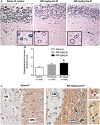
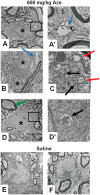




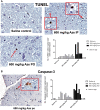

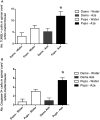


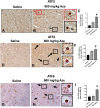




Similar articles
-
L-Proline Prevents Endoplasmic Reticulum Stress in Microglial Cells Exposed to L-azetidine-2-carboxylic Acid.Molecules. 2023 Jun 16;28(12):4808. doi: 10.3390/molecules28124808. Molecules. 2023. PMID: 37375363 Free PMC article.
-
Misincorporation of the proline analog azetidine-2-carboxylic acid in the pathogenesis of multiple sclerosis: a hypothesis.J Neuropathol Exp Neurol. 2008 Nov;67(11):1035-40. doi: 10.1097/NEN.0b013e31818add4a. J Neuropathol Exp Neurol. 2008. PMID: 18957898 Review.
-
Misincorporation of the proline homologue Aze (azetidine-2-carboxylic acid) into recombinant myelin basic protein.Phytochemistry. 2010 Apr;71(5-6):502-7. doi: 10.1016/j.phytochem.2009.12.010. Epub 2010 Jan 11. Phytochemistry. 2010. PMID: 20064647
-
Cell death and mitochondrial dysfunction induced by the dietary non-proteinogenic amino acid L-azetidine-2-carboxylic acid (Aze).Amino Acids. 2019 Aug;51(8):1221-1232. doi: 10.1007/s00726-019-02763-w. Epub 2019 Jul 13. Amino Acids. 2019. PMID: 31302779
-
A comprehensive review of the proline mimic azetidine-2-carboxylic acid (A2C).Toxicology. 2025 Jan;510:153999. doi: 10.1016/j.tox.2024.153999. Epub 2024 Nov 15. Toxicology. 2025. PMID: 39549916 Review.
Cited by
-
L-Proline Prevents Endoplasmic Reticulum Stress in Microglial Cells Exposed to L-azetidine-2-carboxylic Acid.Molecules. 2023 Jun 16;28(12):4808. doi: 10.3390/molecules28124808. Molecules. 2023. PMID: 37375363 Free PMC article.
-
Pro-Inflammatory and Pro-Apoptotic Effects of the Non-Protein Amino Acid L-Azetidine-2-Carboxylic Acid in BV2 Microglial Cells.Curr Issues Mol Biol. 2022 Sep 28;44(10):4500-4516. doi: 10.3390/cimb44100308. Curr Issues Mol Biol. 2022. PMID: 36286023 Free PMC article.
-
Microglia subtypes in acute, subacute, and chronic multiple sclerosis.J Neuropathol Exp Neurol. 2023 Jul 20;82(8):674-694. doi: 10.1093/jnen/nlad046. J Neuropathol Exp Neurol. 2023. PMID: 37344153 Free PMC article.
References
-
- Rubenstein E. Misincorporation of the proline analog azetidine-2-carboxylic acid in the pathogenesis of multiple sclerosis: A hypothesis. J Neuropathol Exp Neurol 2008;67:1035–40 - PubMed
-
- Sobel RA. A novel unifying hypothesis of multiple sclerosis. J Neuropathol Exp Neurol 2008;67:1032–4 - PubMed
-
- Rubenstein E, Zhou H, Krasinska KM, et al.Azetidine-2-carboxylic acid in garden beets (Beta vulgaris). Phytochemistry 2006;67:898–903 - PubMed
-
- Central Intelligence Agency. The World Factbook, Field Listing, Agriculture Products. Washington, DC: Central Intelligence Agency; 2021.
-
- Simpson S Jr, Wang W, Otahal P, et al.Latitude continues to be significantly associated with the prevalence of multiple sclerosis: An updated meta-analysis. J Neurol Neurosurg Psychiatry 2019;90:1193–200. - PubMed
Publication types
MeSH terms
Substances
LinkOut - more resources
Full Text Sources
Medical
Research Materials
Miscellaneous

